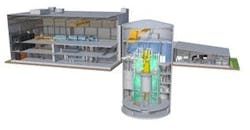Digital transformation is driving the future of the economy, and that driver needs fuel.
An expanding array of potential future microgrid customers, particularly those in information technology and data center industries, are favoring development of advanced and small modular nuclear (SMR) reactors to connect sustainability and power reliability goals.
The U.S. Department of Energy (DOE) is giving nearly a billion other reasons to prove that it’s on board with that.
The DOE announced a notice of intent this week to fund up to $900 million to support deployment of new SMR technologies. The funding, made possible by the Bipartisan Infrastructure Law, will incentivize growth of smaller, advanced nuclear reactor projects.
The current U.S. fleet of more than 90 larger, utility-scale nuclear reactors, mainly owned and operated by the private sector, produces close to 19% of total electric power and more than half of the carbon-free energy generated nationwide. The costs and safety concerns around utility-scale nuclear projects, however, has impeded recent growth of the sector.
Many believe that the nation will not reach its net zero goals without future nuclear power as a flexible, baseload resource. SMR and advanced nuclear with smaller footprints are seen as less costly and more easily deployed opportunities; that is not to say they are inexpensive or uncomplicated.
Interest in SMRs Increasing: What's Their Role in Microgrids?
“President Biden is determined to ensure nuclear power—the nation’s single largest source of carbon-free electricity—continues to serve as a key pillar of our nation’s transition to a safe and secure clean energy future,” Secretary of Energy Jennifer Granholm said in a DOE statement. “Today’s announcement will support early movers in the nuclear sector as we seek to scale up nuclear power and reassert American leadership in this critical energy industry.”
The DOE estimates that the U.S. will need approximately 700 GW to 900 GW of additional carbon-free and firm electricity capacity to reach net-zero emissions by 2050. Solar and wind are intermittent resources, while battery storage is limited by short duration and its own safety and supply chain concerns.
The funding solicitation for this SMR nuclear investment could be released by late summer or fall. The DOE’s Gen III+ Small Modular Reactor Program is part of the Office of Clean Energy Demonstrations and its website can be found here.
Next-gen nuclear projects are underway at various stages nationwide. Earlier this month, Bill Gates-founded startup TerraPower celebrated a groundbreaking ceremony for its planned 345-MW Natrium Reactor Project in Wyoming.
Natrium is the first advanced reactor project to move into the construction stage and is an expected five years away from completion. Other companies such as Oklo, NuScale Power, Westinghouse, X-energy, BWTX and Kairos Power are among those working on SMR designs and possible future demonstrations.
NuScale Power received federal Nuclear Regulatory Commission approval for its reactor design. However, the company’s planned partnership with electric cooperative Utah Associated Municipal Power Systems was terminated late last year because of a shortfall in customer subscriptions that could have made the Idaho National Lab-sited SMR plant economical.
The exponential and sudden rise in anticipated future load from data center and artificial intelligence expansion is fueling consideration of dependable and carbon-free nuclear energy. Tech giants such as Microsoft, Amazon Web Services (AWS) and others are increasingly committed to adopting nuclear as a means of bridging sustainability and resource adequacy goals.
AWS, for instance, recently acquired a data center site that is directly linked to the nearby Susquehanna Nuclear Generation facility in Pennsylvania.
Track small modular nuclear's future role in microgrids and data centers via our free MGK newsletter









